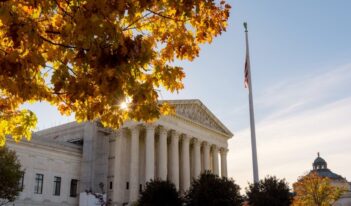
The Trump Administration’s regulatory rollbacks will not have staying power among future administrations.
In a recent essay in The Regulatory Review, I argued that President Donald J. Trump’s Executive Order 13,771, known as the “1-in-2-out” executive order on regulations, has been a categorical policy failure.
I may have been too harsh in my assessment—but certainly not because I have changed my verdict on the executive order’s failure. Rather, the Trump Administration’s experiment with a regulatory budget has been useful in one respect: It has proven that the idea of a regulatory budget does not deserve to be taken seriously in regulatory policy circles, and it shows that imposing a budget on regulations simply does not work in practice.
It appears William Yeatman agrees with me on both counts in his recent essay in The Regulatory Review, which I welcome. There no longer appears to be any real debate as to whether the regulatory budget is good policy. Indisputably, it is not. Indeed, the best that can be said about a regulatory budget is that future Presidents that favor deregulation may find it appealing just for rhetorical or messaging purposes, particularly those politicians like our current President who prefer the “sizzle” over the “steak,” using Yeatman’s apt analogy. But no future administration should harbor any illusions that a regulatory budget makes policy sense.
Nonetheless, Yeatman argues that critics of President Trump’s deregulatory agenda have focused too much on the failed “1-in-2-out” executive order and have failed to recognize that other policy changes initiated by the Trump Administration could have greater staying power, even if President Trump loses the upcoming election. He is certainly right that Executive Order 13,771 has drawn significant attention and criticism, but Yeatman’s belief that other changes will have greater durability ignores that those changes have more in common with Executive Order 13,771 than Yeatman realizes. Just like Executive Order 13,771, these changes suffer from the same basic policy and legal flaws that the Trump Administration is more than willing to ignore when politically convenient, just as it has with 13,771.
Yeatman points to the U.S. Department of Justice’s effort to “modernize and improve” the Administrative Procedure Act (APA). What makes this effort from the Justice Department particularly ironic is that the Administration has violated the APA and had its rules overturned in court as a result in unprecedented fashion.
New York University’s Institute for Policy Integrity has found that the Administration has lost legal challenges on APA grounds an astounding 90 percent of the time, far higher than the historical average. It is quite hypocritical for the Justice Department to claim that the APA needs updating when this Administration has avoided complying with the APA in its current form.
Moreover, the Justice Department’s proposed changes to the APA would hardly be an improvement, and oddly they would rely heavily on an obsolete type of rulemaking process—so-called “formal” rulemaking—as the solution to “modernizing” the APA. Formal rulemaking procedures include in-person, trial-like hearings that would significantly lengthen the current informal rulemaking process, which already suffers from chronic delays and ossification. These procedures have long since been abandoned by agencies because they are inefficient and ineffective compared to the APA’s notice-and-comment process. Of course, that may be a feature, rather than a bug, for those calling for the “deconstruction of the administrative state.”
Arguably, the Administration might be far more persuasive if it subjected its own rulemakings that are top political priorities to the formal rulemaking process. But it has not done so because this process would significantly delay those priorities. To date, the U.S. Department of Transportation’s order allowing formal rulemaking hearings has yet to result in a single hearing and conveniently did not apply to the Department’s deeply flawed rollback of the Obama Administration’s clean car fuel economy standards.
Yeatman also predicts that the Administration’s actions on guidance documents, which culminated in a pair of executive orders that President Trump issued last year, will enjoy longevity. Yet these reforms are nothing new, and they have failed to stick in the past. Former President George W. Bush incorporated many of the same guidance document changes in Executive Order 13,422, but former President Barack Obama promptly repealed that executive order in 2009 when he came into office. President Trump’s executive orders on guidance documents likely will meet a similar fate should he fail to win re-election.
I agree with Yeatman that there are instances in which agencies issue guidance documents where a legally binding rulemaking would be more appropriate. Yet that does not mean that all guidance is rulemaking in disguise, as Yeatman and Trump Administration officials have claimed.
Moreover, it is simply mistaken to state that guidance documents are legally binding, rather than the underlying laws and regulations the guidance interprets. But this is the foundational assumption upon which the Trump Administration guidance document reforms have been built. The intent of these reforms is clear: to chill agency use of guidance documents by imposing procedural requirements—such as notice and comment, cost-benefit analysis, and review by the U.S. Office of Information and Regulatory Affairs (OIRA)—that traditionally have been reserved only for legally binding rules.
There are two reasons the current Administration’s guidance policies will not survive in a new administration.
First, these policies target guidance documents that clarify how to meet regulatory requirements, but not those that provide “safe harbors” from those requirements, such as “no action letters” or similar guidance that is favored and often requested by regulated industries. This asymmetrical and unbalanced approach favors corporate interests and parties over others in arbitrary fashion.
Second, to address public health crises, the Trump Administration has issued guidance documents that appear to violate its own executive orders on guidance. For example, when President Trump was contemplating a badly needed ban on e-cigarettes to stop the youth vaping epidemic, the Administration’s initial action took the form of guidance. But conservatives and industry opponents of the ban argued that it violated the President’s executive orders on guidance. Regrettably, opponents of the ban were successful in delaying and weakening the guidance. This example illustrates both that guidance documents can be crucial to government action that protects the public and that President Trump’s guidance document changes could still pose obstacles for the next administration when it seeks to address public health crises and other urgent threats. For that reason, we should expect the next administration to repeal the Trump guidance policies.
There is one unquestionably good reform that should be kept in future administrations, although it is hidden within a larger policy change that is unlikely to survive. Specifically, the Administration extended OIRA’s authority under Executive Order 12,866 to review tax regulations from the Internal Revenue Service (IRS) in 2018. This is unquestionably good because of the more reasonable time frames placed on OIRA review of IRS rules. Of course, given a robust debate in progressive policy circles about the wisdom of OIRA’s mere existence, it is hard to imagine any expansion of OIRA authority having any place in the next administration.
However, if OIRA still exists in the next administration, one feature of OIRA’s review of IRS rules should be extended to review of rules from all agencies. For IRS rules, OIRA must complete its review within 45 days, instead of the 90-day review period set out in Executive Order 12,866. For IRS rules implementing the Trump tax cut law that had recently passed at the time, OIRA was given only ten days to review those rules.
It is not at all clear what is different or special about IRS rules that justify a shorter OIRA review period than all other rules reviewed by OIRA. Rather, these shorter review periods likely represent an acknowledgment of longstanding concerns about delays at OIRA, which the IRS may have seen could hold up implementation of political priorities such as the tax cut law. In seeking to expand OIRA’s authority, the Trump Administration ironically has laid the groundwork to scale back that authority by reducing OIRA review periods from 90 to 45 days. That would be one small but good change if extended to all agencies by a future administration.
Overall, though, given how badly President Trump’s regulatory rollbacks have fared both in the court of law and in the court of public opinion, it is likely that most of the regulatory policies adopted by the current Administration will not last long. Those who believe President Trump’s broader regulatory process changes will have more staying power are only setting themselves up for disappointment.
This essay is part of a five-part series, entitled Debating the Repercussions of Trump’s Deregulatory Agenda.




